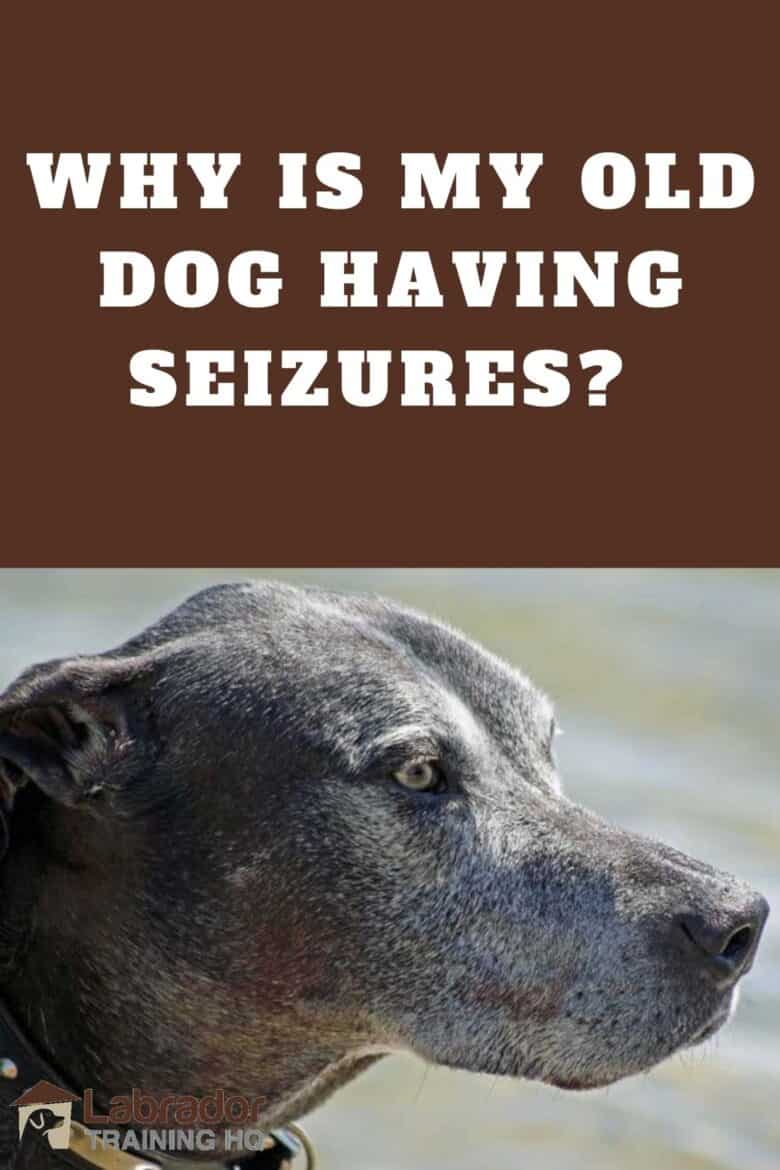This post may contain affiliate links. We may earn money or products from the companies mentioned in this post.

It is very worrying when your older dog suddenly starts having seizures. You are left to wonder whether they are sick or if it is a sign that your dog is in its final days.
You are right to be concerned, as seizures are not common among dogs, even as they enter their older years. If they start having seizures, it is a sign that something is wrong.
A wide variety of things could cause your older dog to have seizures, some minor and some serious.
Without you knowing, they might have eaten something that they shouldn’t have, which is something that is relatively easy to treat.
However, they might also be suffering from a serious illness such as kidney or liver disease.
The only way to know for certain, and the only way to get your dog the treatment that they need, is to go to the vet.
The vet clinic can run a battery of tests to figure out what exactly is happening with your dog, and what needs to be done for them.
But to help you better understand and manage this scary process, in today’s article we will go through what exactly a seizure is and what it looks like at its various stages.
We will also go through what you should do if your dog is having a seizure, to give them the best chance of being properly diagnosed and to recover.
We will finish off by taking a look at some of the most common causes of seizures in senior dogs.
Contents & Quick Navigation
What Are Dog Seizures?
A seizure is an involuntary electrical disturbance in the brain that is typically accompanied by uncontrollable body movements and changes in behavior and consciousness levels.
What it actually looks like when your dog is having a seizure varies greatly depending on the type of seizure and its cause.
It can also vary significantly in how long it lasts. A seizure could last a few seconds, or it could last several minutes. The longer the seizure lasts, the more dangerous it is to your dog.
However, you can be reassured that the seizure itself is not painful for your dog, unless they accidentally fall against something or hit something while they are not in control of their body movements.
However, it is generally very disorienting, so they may feel fearful after the fact.
There are four different types of seizures in dogs.
Grand Mal Seizure, or Generalized Seizure — This affects both sides of the brain and will cause your dog to lose consciousness, and all of their limbs to move and twitch spasmodically.
Focus Seizure — This type of seizure only affects a single area of the brain, and will generally create abnormal movements on one side of the body or in one limb only.
If your dog continues to have seizures, very often focus seizures will progress into generalized seizures.
Psychomotor Seizures — These are the most difficult seizures to identify, as rather than losing consciousness, your dog will behave strangely such as attacking an object that is not really there.
Since dogs do this type of thing all the time, it is hard to know whether this is just them being loopy or something more serious.
However, if your dog is doing this during a recurring seizure, they will repeat the same strange behavior each time.
Idiopathic Epilepsy — When the cause of repeating seizures in a dog is unknown, this is known as idiopathic epilepsy.
This is an inherited condition that is more common in some breeds than others, including Labrador retrievers.
However, it is very unusual for an older dog to suddenly start displaying idiopathic epilepsy. It is almost always diagnosed within the first six years of a dog’s life.
The Three Stages Of Dog Seizures?
While the main convulsion stage of a seizure is the one that we are most aware of, seizures actually have three distinct stages.
Pre-Ictal Stage
The pre-ictal stage is the lead up to the seizure. It may start just a few minutes before the main phase of the seizure or several hours before.
It happens first because your dog is aware that something is wrong and will start to behave differently. Secondly, the brain is already beginning to misfire, which can cause your dog to act strangely.
What exactly the pre-ictal stage looks like varies significantly but you can expect your dog to seem distressed.
They may hide from you, or on the contrary they may stick very close to you, depending on their temperament. They might also cry or otherwise try to indicate to you that they are in distress.
You may also find that your dog is wandering around aimlessly, or is experiencing temporary blindness.
They may have a tendency to engage in compulsive behavior at this time. It is also not uncommon for them to feel increased hunger or thirst at this stage of a seizure.
Ictal Stage
Next is the seizure itself, which as we have already discussed will look different depending on the type of seizure they are having.
While this is the scariest part of the seizure for pet parents, your dog is not in pain during this stage of the seizure.
The biggest risk to them is accidentally knocking into something or falling down stairs when they are not in control of their body.
This part of the seizure can last for anywhere from a few seconds to several minutes, but somewhere between 30 seconds and two minutes is most common.
If the seizure lasts for more than two minutes, your dog’s body can overheat and they can be at risk of hyperthermia.
Post-Ictal Stage
This is the recovery stage of the seizure, which again varies greatly. Some dogs bounce back quickly, while others may still feel disoriented 24 hours after the main episode.
Your dog may feel disoriented and distressed, as they do not understand what has happened to them.
They can also continue to experience a lack of coordination, as the brain is still misfiring and disrupting their motor control.
What To Do When Your Dog Has A Seizure
Part of the reason it can feel so distressing when your dog is having a seizure is that you will probably feel powerless to help them.
But, while they will need to get through the seizure themselves, there are a variety of things you can do to support them before, during, and after a seizure.
Stay Calm
The most important thing you can do for your dog is to stay calm. You know that your dog picks up on your emotions, so if you panic, they might panic as well. If you keep calm, they will be reassured that everything is OK.
Seizures can be very disorienting for dogs, as they do not understand what is happening to them.
Having a familiar, calm, and loving presence near them during and after the seizure will help them better respond to the situation.
Remove Hazards
One of the biggest dangers to dogs during a seizure is that they might accidentally hurt themselves while they do not have control of their bodies.
So, while they are having a seizure, move anything potentially dangerous outside of their reach.
Your dog can also have reduced motor function during the pre- and post-ictal stages of the seizure. So at this time, it can be a good idea to protect your dog from hazards.
This could include putting barriers over stairwells to prevent them falling, and covering sharp corners on furniture so that they do not accidentally bang into any of them.
Time The Seizure
When you speak to your vet about the seizure, they will want to know details about what exactly the seizure looked like and how long it lasted, and if they had multiple seizures, the time between them.
So, while the last thing you might want to be doing while your pup is in distress is to be looking at the clock, make sure to take a note of these details in order to aid in diagnosis.
Cool Them Down
If your dog’s seizure lasts more than two or three minutes, their body temperature will probably rise dramatically, and they can experience hyperthermia.
You can try to prevent this by cooling them down. Apply cold, wet towels to their neck, paws, and groin areas.
Don’t Worry About Their Tongue
It is a common misbelief that both dogs and humans are at risk of swallowing their tongue when they are having a seizure, but this does not happen.
If you do try to stick your hand in your dog’s mouth during a seizure to move their tongue, the most likely outcome will be that they inadvertently bite you.
Speak To Your Vet
Even if your dog seems fine after the seizure, speak to your vet. Dogs don’t just have seizures for no reason—it will be a symptom of something else that probably requires treatment.
If your dog has a seizure that lasts for more than two minutes, or has more than one seizure within the space of 24 hours, don’t wait. Immediately take your dog to an emergency vet.
The Most Common Causes Of Seizures In Senior Dogs
There are a variety of different underlying problems that might cause seizures in older dogs.
Some are more serious than others, and some are more treatable than others, so you will need to speak to your vet to find the best course forward.
The one major seizure condition that your dog is not likely to have if they suddenly start having seizures when they are older is epilepsy.
This is an inherited condition and is almost always diagnosed within the first six years of a dog’s life.
Here are some of the most common conditions likely to be affecting your dog.
Poisoning
If your dog ingests something toxic, their body might respond with seizures. This can include medications, foods, or household cleaners.
Your vet will probably have questions about what they might have ingested, and some of the first tests that they will run will be to rule out poisoning.
Some of the most common poisons that might cause seizures include a variety of medications, such as ibuprofen and penicillin, toxic plants such as mushrooms, common human foods that are poisonous to dogs such as caffeine, chocolate, and the sugar substitute xylitol, and household cleaners and poisons.
You can read a more complete list of the foods that are toxic for dogs here.
Brain Tumor
This is one of the most common causes of seizures in senior dogs, as opposed to young ones.
The responsible tumor may be malignant or benign. If your vet suspects a tumor, they will order a CT or MRI, and if a tumor is identified, they will require a biopsy.
Head Trauma
Any trauma to the brain may also cause seizures, and older dogs are more prone to this than younger ones as they lose their coordination and eyesight as they age.
You may notice other disoriented behavior prior to the seizure if your dog has had head trauma.
Liver or Kidney Disease
If your dog has liver or kidney disease advanced enough to cause seizures, they will likely also be experiencing other symptoms such as loss of appetite, digestive upsets, and darkening of the urine.
Hypoglycemia
This is most common in dogs with undiagnosed diabetes, or that are being treated for diabetes and have received too much insulin.
Hypothyroidism
When something goes wrong with the thyroid, the whole body is thrown into chaos due to hormonal imbalances. Seizures are just one type of many symptoms that you can expect, including rapid weight gain or loss.
You will need to speak to your vet to determine which of these conditions, or the various other conditions that can cause seizures, is affecting your pooch.
There are also some other conditions that can cause symptoms that look a bit like a seizure but are in fact something else.
For example, if your dog has a severe ear infection, this can cause a lack of balance and coordination, and can also affect the nerves in the facial muscles.
A severe allergic reaction may also cause a loss of balance, strange behavior, and even a loss of consciousness.
A transient ischemic stroke is a mini-stroke caused by reduced blood flow to the brain, usually caused by a blood clot. While this sounds serious, it usually passes quickly and causes no long-term problems for your dog.
If you want to know more about what might be affecting your Labrador’s health, read our round-up of the most common Labrador health conditions and how to prevent them.
FAQs
Why Would An Older Dog Start Having Seizures?
There are a variety of reasons why your dog might start having seizures later in life. It is a common symptom of a variety of medical conditions, from poisoning to kidney disease.
The only way to discover the cause of your dog’s seizures is to consult with your vet. They will run a variety of tests to determine the cause of the seizures and to suggest treatment.
How Common Are Seizures In Senior Dogs?
Seizures are not common in older dogs. They are a symptom of a variety of potential medical conditions, so you should take your dog to the vet immediately if they begin to have seizures.
Should I Put My Dog Down If They Have Seizures?
You do not immediately need to put your dog down if they start having seizures. These can be an indication of a variety of medical conditions, some of which are easy to treat.
Others, though, may result in your dog needing to be put down. But you will need to seek a proper diagnosis of your dog’s condition before making any kind of decision.
What Foods Trigger Seizures In Dogs?
A variety of foods that are toxic to dogs can result in seizures.
Some of the most commonly ingested foods that cause seizures in dogs include mushrooms, xylitol (a sugar replacement common in human foods), caffeine, and dark chocolate.
This is one of the reasons that you should never feed your dog food off your plate.
How Do You Calm A Dog Down After A Seizure?
Seizures are not painful for your dog while they are happening, but they can be disorienting and scary after the fact.
The best thing you can do for your dog during a seizure is to ensure that they are not close to anything on which they may be able to hurt themselves when they are not in control of their body.
After the seizure, you should remain close to your dog and give them affection in a calm manner. This will reassure them that everything is OK.
The Verdict
As dogs get older, their health deteriorates, and you might notice a lot of changes in them. It can be challenging to know which of these you should be worried about, and which are just a normal part of aging.
If your dog does start having seizures as they get older, this is cause for concern.
This is not a normal part of the aging process and could be a symptom of a number of different medical conditions, some treatable and others more serious.
If your older dog starts having seizures, schedule a vet visit and make sure you record all the information about the incident to help with a diagnosis.
You also need to support your pup through the seizure by being a calm and reassuring presence among all the stress and confusion, and by ensuring they don’t hurt themselves while they aren’t in control of their bodies.
Have you dealt with an older dog having seizures? Share your experiences with the community in the comments section below.
Save To Pinterest

Top Picks For Our Dogs
- BEST PUPPY TOY
We Like: Snuggle Puppy w/ Heart Beat & Heat Pack – Perfect for new puppies. We get all of our Service Dog pups a Snuggle Puppy. - BEST CHEW TOY
We Like: KONG Extreme – Great toy for heavy chewers like our Labrador Retrievers. - BEST DOG TREATS
We Like: Wellness Soft Puppy Bites – One of our favorite treats for training our service dog puppies. - BEST FRESH DOG FOOD
We Like: The Farmer’s Dog – A couple months ago we started feeding Raven fresh dog food and she loves it! Get 50% off your first order of The Farmer’s Dog.
For a list of all the supplies we get for our new service dog puppies check out our New Puppy Checklist on the PuppyInTraining.com blog.
Why Is My Older Dog Suddenly Having Seizures? was last modified: February 19th, 2021 by


